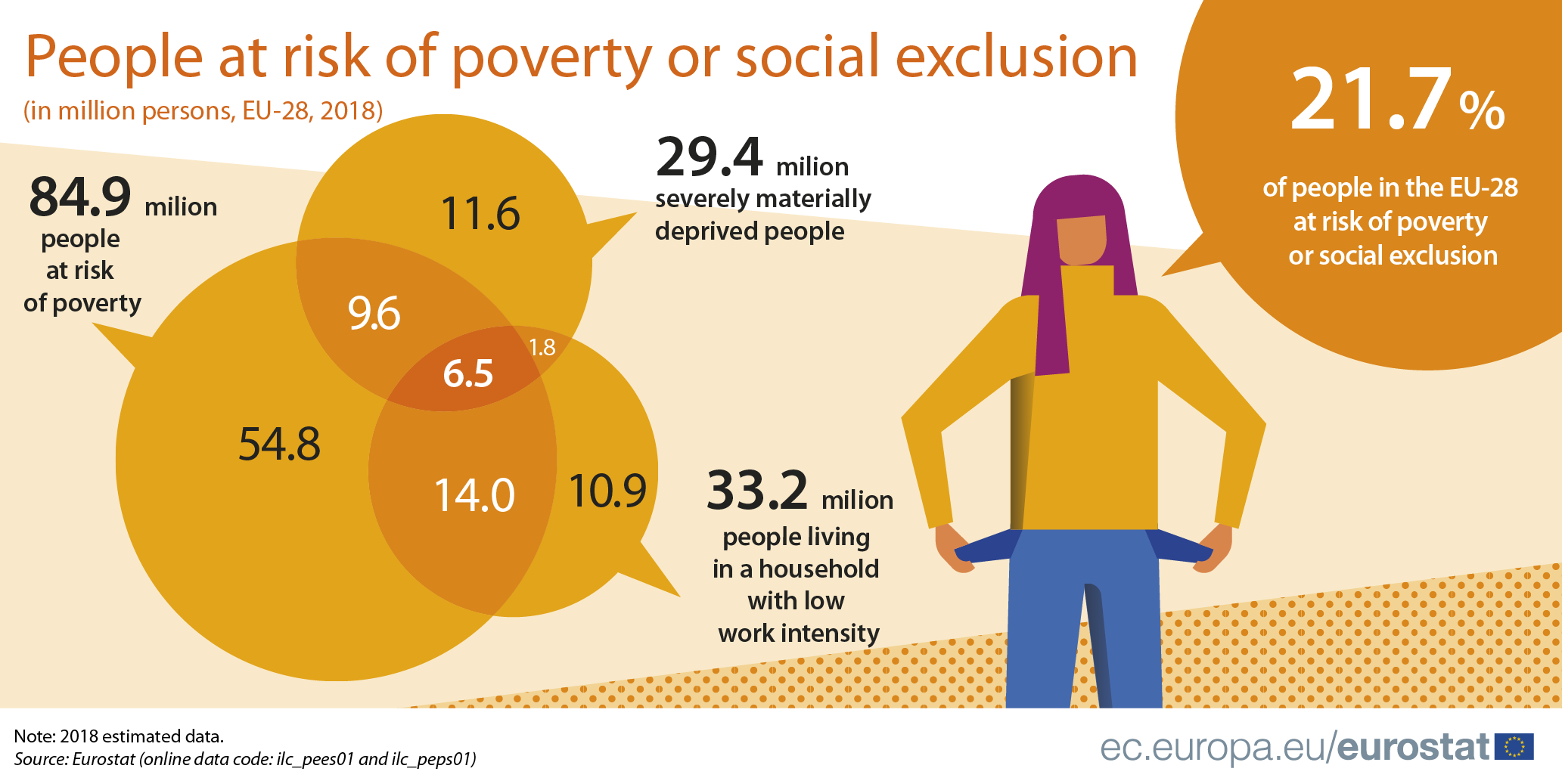540 euros in Portugal against 1,060 euros in Germany: the poverty lines, calculated according to the median standard of living in each country, vary widely in Europe.
The least poor in Europe live in Switzerland and Norway where the poverty line exceeds 1,300 euros per month according to Euro-stat (2016 data, threshold at 60% of the median standard of living). Austria, Germany, the Netherlands, Denmark, Belgium and France are the other countries where the poverty line is above 1,000 euros per month. At the very bottom of the scale, the Romanian threshold (265 euros) is the lowest. Countries in southern and eastern Europe are also among those with the lowest poverty line: the poverty line is often twice as low as it is in the wealthiest countries, and even even lower.
Also Interesting to Read: 25 POOREST COUNTRIES IN THE WORLD
These thresholds give an idea of the differences in standards of living that persist within Europe. The poor in southern and eastern Europe live in conditions far removed from most poor people in the wealthiest countries. In nearly ten countries, the heart of poverty (poverty line at 40% of the median standard of living) is around 300 euros monthly (much less in Romania which shows a threshold at 177 euros): the poorest live on the equivalent of 10 euros per day (for a single person). These data make it possible to measure the extent of what remains to be done to ensure real convergence in living standards in Europe.
Wage inequality between women and men in Europe
Women on average earn wages 16% lower than men in Europe. This gap reaches 21% in Germany and the Czech Republic, compared to 5% in Italy and 3.5% in Romania.
On average, women earn 16% less than men in Europe, according to 2017 data from the European Statistical Institute Euro-stat . This difference is highest in the Czech Republic (21.1%) and in Germany (21.0%). France is just below the European average, at the same level as the Netherlands and Spain: women earn on average 15.4% less than men.
Also Read: 10 POOREST COUNTRIES IN EUROPE
These data should be viewed with great care. To think that the gap in Germany is four times greater than it is in Italy is strange to say the least. Euro-stat does not give any clear explanation of the differences in survey methodology which could explain the differences between certain countries. The organization posts for example on its site an equality between the wages women / men Italian for full time, which seems hardly credible.
The data on trends in wage inequality seem more interesting to analyze even if, here too, countries change their methods over time. Since 2010, the wage gap between women and men has narrowed very little in Europe: a drop of only 1.1 percentage points over the period (17.1% in 2010 compared to 16% in 2017). In some countries, such as Croatia and Portugal, the differences increase, unless again the difference results from a change in method in the meantime. In contrast, Romania, Belgium and Austria show wage inequalities that fell by around four to five percentage points between 2010 and 2017.
| Pay gap between women and men in Europe Women earn …% less than men | |||
|---|---|---|---|
| 2010 | 2017 | Evolution (in% points) | |
| Czech republic | 21.6 | 21.1 | – 0.5 |
| Germany | 22.3 | 21.0 | – 1.3 |
| United Kingdom | 23.3 | 20.8 | – 2.5 |
| Austria | 24.0 | 19.9 | – 4.1 |
| Slovakia | 19.6 | 19.8 | 0.2 |
| Swiss | 17.8 | 17.0 | – 0.8 |
| Finland | 20.3 | 16.7 | – 3.6 |
| Portugal | 12.8 | 16.3 | 3.5 |
| European Union | 17.1 | 16.0 | – 1.1 |
| France | 15.6 | 15.4 | – 0.2 |
| Netherlands | 17.8 | 15.2 | – 2.6 |
| Spain | 16.2 | 15.1 | – 1.1 |
| Denmark | 17.1 | 14.7 | – 2.4 |
| Norway | 16.1 | 14.3 | – 1.8 |
| Hungary | 17.6 | 14.2 | – 3.4 |
| Ireland | 13.9 | 13.9 | 0.0 |
| Bulgaria | 13.0 | 13.6 | 0.6 |
| Sweden | 15.4 | 12.6 | – 2.8 |
| Greece | 15.0 | 12.5 | – 2.5 |
| Croatia | 5.7 | 11.6 | 5.9 |
| Poland | 4.5 | 7.2 | 2.7 |
| Belgium | 10.2 | 6.0 | – 4.2 |
| Italy | 5.3 | 5.0 | – 0.3 |
| Romania | 8.8 | 3.5 | – 5.3 |
2016 data for Greece and Ireland. Calculation of the pay gap: difference in average gross hourly wages between men and women workers, as a percentage of average gross hourly wages for men. Employees in industry, construction and services (excluding public services). Interpretation: in the Czech Republic, the average gross hourly wage of women is 21.1% lower than the average gross hourly wage of men in 2017.
What are the per ca-pita incomes in Europe?
46,000 euros in Sweden against 19,000 euros in Romania. In Europe, the annual income per adult is more than twice as high in the rich countries than in the poorest countries.
In Sweden and Ireland, the average income per adult is more than twice as high as in Romania, according to 2017 data from the World Inequality database. On the one hand, it exceeds 40,000 euros annually, on the other, it is less than 20,000 euros. The European average is 28,000 euros. The countries where the inhabitants are the poorest are the countries of Eastern Europe (Romania, Hungary, Poland and the Czech Republic), Greece and Portugal. France is above the European average with more than 35,000 euros on average.
In the space of almost twenty years (2000-2017), most European countries have experienced an increase in the wealth of their inhabitants. The average increase in Europe is 5,500 euros per adult, or almost + 25%. Overall, despite the crisis of the late 2000s, we live better on the old continent. The increase in wealth during this period is spectacular in Sweden (+ 12,000 euros). But income per adult has also increased by almost two (+ 91%) in Romania: the gain, of more than 9,000 euros annually between 2000 and 2017, is four times greater than in France. The former countries of the Soviet bloc are also experiencing significant increases, between +6,000 and +7,000 euros in average annual income per adult.
Also Read: Extreme poverty in the world is shrinking
In contrast, Greece and Italy were severely affected by the crisis: the income of their inhabitants fell between 2000 and 2017: respectively – 4,000 euros and – 2,400 euros. In Portugal, the standard of living has stagnated during these 17 years. For its part, Ireland is experiencing an atypical trajectory: the standard of living decreases markedly between 2005 and 2010, then makes an extraordinary jump of + 9,900 euros between 2010 and 2017, an increase of 29%. The country is in second place in our European ranking.
From a global point of view, the average national income per adult illustrates fairly well the hierarchy of living standards between European countries. It reveals very contrasting situations, without it being possible to speak of either real convergence or divergence in living standards. This indicator should be used with caution as it does not reflect the distribution of wealth within countries. There are inequalities in inequality! Thus, for example, Ireland has attracted many companies because of a tax rate much lower than the rest of Europe, but the wealth thus captured is far from having benefited all its inhabitants. Similarly, Romania has developed, but there is still a large fraction of the population living there in misery: The Poverty rate in this country is the highest in Europe.
Poverty line in Europe

